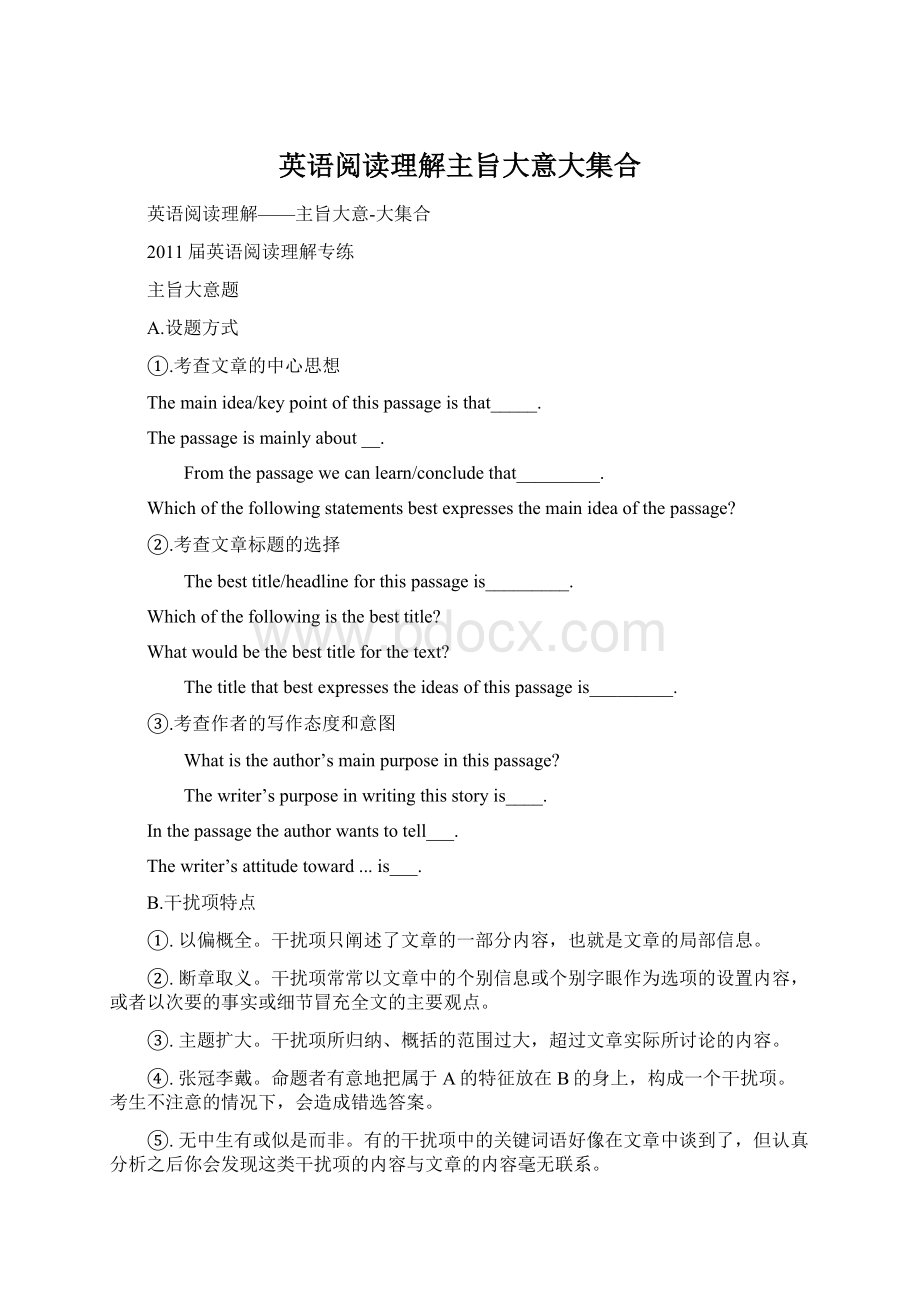英语阅读理解主旨大意大集合.docx
《英语阅读理解主旨大意大集合.docx》由会员分享,可在线阅读,更多相关《英语阅读理解主旨大意大集合.docx(44页珍藏版)》请在冰豆网上搜索。

英语阅读理解主旨大意大集合
英语阅读理解——主旨大意-大集合
2011届英语阅读理解专练
主旨大意题
A.设题方式
①.考查文章的中心思想
Themainidea/keypointofthispassageisthat_____.
Thepassageismainlyabout__.
Fromthepassagewecanlearn/concludethat_________.
Whichofthefollowingstatementsbestexpressesthemainideaofthepassage?
②.考查文章标题的选择
Thebesttitle/headlineforthispassageis_________.
Whichofthefollowingisthebesttitle?
Whatwouldbethebesttitleforthetext?
Thetitlethatbestexpressestheideasofthispassageis_________.
③.考查作者的写作态度和意图
Whatistheauthor’smainpurposeinthispassage?
Thewriter’spurposeinwritingthisstoryis____.
Inthepassagetheauthorwantstotell___.
Thewriter’sattitudetoward...is___.
B.干扰项特点
①.以偏概全。
干扰项只阐述了文章的一部分内容,也就是文章的局部信息。
②.断章取义。
干扰项常常以文章中的个别信息或个别字眼作为选项的设置内容,或者以次要的事实或细节冒充全文的主要观点。
③.主题扩大。
干扰项所归纳、概括的范围过大,超过文章实际所讨论的内容。
④.张冠李戴。
命题者有意地把属于A的特征放在B的身上,构成一个干扰项。
考生不注意的情况下,会造成错选答案。
⑤.无中生有或似是而非。
有的干扰项中的关键词语好像在文章中谈到了,但认真分析之后你会发现这类干扰项的内容与文章的内容毫无联系。
C.解题指导
1.分清主次,抓住主干,找出主题句。
主题句是归纳表达文章中心思想的句子,它的出现有四种情况:
1)主题句在开头。主题句出现在段落或文章的开头部分,起着开宗明义、点明主题的作用,它可以使读者一开始就明白文章所讲的内容主旨。而支撑句则使用一些具体的人、物、数字或具体的步骤来阐述或论证主题,常伴有forexample\i.e.\thatis\first\second\finally\once\anothertime\foronething等词。
2)主题句在结尾。用归纳法写的文章,其结构是表述细节的句子放在前面,概述性的句子放在后面,并以此而结尾,所以结尾的句子起着总结归纳、画龙点睛的作用,多伴有so\therefore\thus\inshort\asaresult\thatiswhy等词。
3)考生可以快速浏览每段首尾两句来确定每段的主题句,从而确定文章的主题句。
【考例分析1】Everydayweexperienceoneofthewondersoftheworldarounduswithoutevenrealizingit.Itisnottheamazingcomplexityoftelevision.Northeimpressivetechnologyoftransport.Theuniversalwonderweshareandexperienceisourabilitytomakenoiseswithourmouths,andsotransmitideasandthoughtstoeachother‘sminds.Thisabilitycomessonaturallythatwetendtoforgetwhatamiracle(奇迹)itis.
75.Thispassageismainlyabout_________.(2010·江西卷·E-节选自文章第一段)
A.thedevelopmentofbodylanguage
B.thespecialrolehumansplayinnature
C.thepowertoconveyinformationtoothers
D.thedifferencebetweenhumansandanimalsinlanguageuse
【考例分析2】MyfewminuteswithMr.Galbreathchangedmylife.NowItrytotreateveryonewithrespect,nomatterwhoIthinktheyare,andnomatteranotherhumanbeingwithkindnessandsincerity.
59.Whatisthemessagemainlyexpressedinthestory?
(2010年重庆卷A篇-节选自文章最后一段)
A.Weshouldlearntobegenerous.
B.Itishonorabletohelpthoseinneed.
C.Peopleinhighpositionsarenotlikewhatweexpect.
D.Weshouldavoidjudgingpeoplebytheirappearances.
【考例分析3】Weoftendon’trememberthingsaswellwhenwe’retryingtomanageseveraldetailsatthesametime.Withoutmentalfocus,wemaynotpayenoughattentiontonewinformationcomingin,soitnevermakesitintoourmemorystores.Thatisoneofthemainreasonsweforgetpeople’snames---evensometimesrightaftertheyhaveintroducedthemselves.Multitaskingcanalsoaffectourrelationships.Ifsomeonecheckstheire-mailwhileonthephonewithafriend,theymaycomeoffasabsent-mindedordisinterested.Itcanalsocausethatpersontomissoroverlookkeyinformationbeingpassedontothem.
52.Whatisthemainideaofthepassage?
(2010年浙江卷C篇-节选自文章最后一段)
A.Multitaskinghasbecomeawayoflife.
B.Multitaskingoftenleadstoefficiencydecline.
C.Multitaskingexercisesneedtobeimproved.
D.Multitaskingenablespeopletorememberthingsbetter.
4)值得注意的是:
有些文章和段落无明显的主题句,只是暗示性地体现主题。这就要求考生在阅读过程中,根据文章中所叙述的事实或提供的线索来概括和总结文章的大意。
2.理清层次关系,,选出最佳标题
标题是文章中心思想的精练表达,多为一个名词词组,短小明了,函盖性强。做这类题目时,要在阅读全文的基础上,把握好层次关系。
注意选项的归纳范围要恰如其分,干扰项往往是局部信息,是某一小节或文章里的某一句。
所以我们在解题时要反复推敲,把概括范围过窄或过宽的选项过滤掉。
【考例分析4】Whenyou’relyingonthewhitesandsoftheMexicanRiviera,thestresses(压力)oftheworldseemamillionmilesaway.Hey,stop!
Thisisnovacation-youhavetofinishsomething!
49.Whatwouldbethebesttitleforthetext?
(2010年全国卷IIB篇-节选自文章第一段)
A.AdventuresinTravelWritingB.WorkingasaFoodCritic
nomedicine,duringtheexperiment.Neitherthevolunteersnortheresearchersknewwhoreceivedwhichpill.Theresearchersthenmeasuredlevelsofcapsaicin,whichisusedinresearchtocausecoughingandasasignofhowwellthemedicineisstoppingcoughs.
Theteamfoundthat,whenthevolunteersweregiventheobromine,thecapsaicinneededtoproduceacoughwasaroundathirdhigherthanintheplacebogroup.Whentheyweregivencodeinetheyneedonlyslightlyhigherlevelsofcapsaicintocauseacoughcomparedwiththeplacebo.
Theresearcherssaidthattheobromineworkedbykeepingdownanerveactivity(神经活动),whichcausescoughing.Theyalsofoundthatunlikesomestandardcoughtreatments,theobrominecausednosideeffectssuchassleepiness.
(2008全国卷IID篇)
a.Whichofthefollowingwouldbethebesttitleforthetext?
A.Codeine:
ANewMedicineB.ChocolateMayCureCoughs
C.CoughTreatment:
AHardCaseB.TheobromineCanCauseCoughs
2)文尾归纳要点,提出建议,以概括主题。
即归纳法写作方式。
如:
Ahumanbodyappearstoberathersoftanddelicate,comparedwiththatofawildanimal,butitisactuallysurprisinglystrong.Indeed,itsverysoftnessandloosenessisanadvantage;itmakesamangoodatmovingaboutmovementofalllivingthingsofhisownsize,becausehecandosomanydifferentthingswithhislimbs.Man’sgamesshowhowhecancontrolhisownbody.Nootherlandcreaturecanswimasskillfullyasman;nonehassuchvariedgrace;veryfewliveaslongashe;noneissostronginitsnaturalresistancetodisease.Thereforemanhasagreatadvantageinhisbattleagainsttherisksofdamageanddeaththatthreatenhim.
3)文中。
通常前面只提出问题,文中的主题由随之陈述的细节或合乎逻辑的引申在文中导出,而后又作进一步的解释、支持或发展。
如:
Nothingisasusefulasaflashlightinadarknightifatiregoesflat.Fewinventionsaresohelpfultoachildwhoisafraidofthedark.Infact,themodernflashlightbringslighttomanydarksituations.Findingsomethinginthebackofaclosetiseasywithaflashlightinhand;acamperalsoneedsoneafterthelightofthecampfirehasbeenout.
4)首尾呼应。
为突出主题,作者先提出主题,结尾时再次点出主题,这种首尾呼应的写作方式较为多见。
但前后表述主题的句子不是简单的重复,后面的表述往往有进一步引申或发展的意味。
如:
(首段)ShuPulonghashelpedatleast1000peoplebittenbysnakes,“Itwasseeingpeoplewithsnakesbitesthatledmetothecareer.”Shesaid…
(尾段)“ThesadstorytouchedmesomuchthatIdecidedtodevotemyselftohelpingpeoplebittenbysnakes.”Shusaid.
5)无主题句,即主题句隐含在全文中,没有明确的主题句,必须根据文中所提供的事实细节进行全面考虑、综合分析,然后找出共同的东西,归纳成一般概念。
必须注意的是,既不能以偏概全,也不能在概括时过于宽泛,要恰如其分。
如:
b.JoshuaBinghamstudied4yearsattheUniversityofParisanddecidedtoleavehisgraduation.HetransferredtotheUniversityofBerlinandgraduatedwithhonors.HarvardLawSchooland,later,BostonCollegeprovidedhimwithanexcellentlegalbackground.HeispresentlyacorporationlawyerinMiami,Florida.
b.Whatisthemainideaofthepassage?
A.HowJoshuaBinghambecamealawyer.B.Binghamisadiligentstudent.
C.JoshuaBinghamreceivedanexcellenteducation.
D.Agoodlawyerneedsgoodeducation.
除了以上主题句呈现的常见形式外还要注意标志词。
文章或段落的主题句常常会出现在一些标志性的提示后。
如:
onthewhole,asaresult,inshort,therefore,thus…Iagreewiththeopinionthat…;Givenallthesepointsabove,Iwouldsupporttheideathat…;Forallthereasonsmentionedabove,Iwouldprefer...
2.抓住文章段落大意,概括中心思想
寻找整篇文章的中心思想是建立在寻找具体段落中心的基础上的。
各段落中心句的整体归纳便是文章的中心思想。
在这个过程中,考生不能只依据只言片语,或光看文章的某些段落,而应观察全文的结构安排;理解文章浓墨重笔写的“重心”;考虑文章的组织材料及支持性细节是服务于什么的;分析故事的发展结局都是围绕什么内容来表达的;最后用简明扼要的文字将文章的中心思想表达出来。
如:
Therearethreeseparatesourcesofdangerinsupplyingenergybynuclearpower.
First,theradioactivematerialmusttravelfromitsplaceofproductiontothepowerstation.Althoughthepowerstationsthemselvesarestronglybuilt,thecontainersusforthetransportofthematerialsarenot.Normally,onlytwomethodsoftransportareinuse,namelyroadorrail.Unfortunately,bothofthesemayhaveaneffectonthegeneralpublic,sincetheyaresuretopassnear,oreventhrough,heavilypopulatedareas.
Second,thereistheproblemofwaste.Allnuclearpowerstationsproducewastesthatinmostcaseswillremainradioactiveforthousandsofyears.Itisimpossibletomakethesewastesnonradioactive,andsotheymustbestoredinoneoftheinconvenientwaysthatscientistshaveinvented.Forexample,theymaybeburiedundertheground,ordroppedintodesertedmines,orsunkinthesea.However,thesemethodsdonotsolvetheproblem,sinceanearthquakecouldeasilybreakthecontainers.
Third,theremayoccurthedangerofaleak(泄漏)oranexplosionatthepowerstation.Aswiththeothertwodangers,thisisnotverylikely,soitdoesnotprovideaseriousobjectiontothenuclearprogram.However,itcanhappen.
Separately,thesethreetypesofdangersarenotagreatcauseforworry.Takentogether,though,theprobabilityofdisasterisextremelyhigh.
c:
Whatisthepassageabout?
A.Usesofnuclearpower.B.Dangersfromnuclearpower.
C.Publicangeratnuclearpower.D.Accidentscausedbynuclearpower.
3.抓住文章主线和关键词语,归纳文章中心
不是所有的段落都有主题句,有时主题句暗含在句中。
阅读这样的文章,就需要自己根据文章的细节来分析,概括出段落的主题,从而推导出文章的主旨。
方法是:
先弄清该段落主要讲了那几方面内容,这些内容在逻辑上有什么联系,然后加以归纳,形成主题。
如:
TheQueen’sEnglishisnowsoundinglessupper-class,ascientificstudyoftheQueen’sChristmasbroadcastshasfound.ResearchershavestudiedeachofhermessagestotheCommonwealthcountriessince1952tofindoutthechangeinherpronunciationfromthenobleUpperReceivedtotheStandardReceived.
JonathanHarrington,aprofessoratGermany’sUniversityofMunich,wantedtodiscoverwhetheraccent(口音)changesrecordedoverthepasthalfcenturywouldtakeplacewithinoneperson.“AsfarasIknow,therejustisnobodyelseforwhomthereisthissortofbroadcastrecords,”hesaid.
Hesaidthenoblewayofpronouncingvowels(元音)hadgraduallylostgroundasthenobleupper-classaccentoverthe